20.04.2022
Happy anniversary, Ingenuity! Mars helicopter flew for the 1st time one year ago today
Ingenuity aced its "Wright Brothers moment" a year ago — and it's still going strong.

NASA's Ingenuity Mars helicopter conducts its 13th Red Planet flight in this image captured by the Mastcam-Z camera system on NASA’s Perseverance rover on Sept. 4, 2021. (Image credit: NASA/JPL-Caltech/ASU/MSSS)
One year ago today (April 19), an aircraft flew on a world beyond Earth for the first time ever.
That history-making vehicle is NASA's Ingenuity Mars helicopter, which landed inside the Red Planet's Jezero Crater with the life-hunting, sample-caching Perseverance rover on Feb. 18, 2021. Just over two months later, the 4-pound (1.8 kilograms) Ingenuity made its first foray into the Martian skies, hovering about 10 feet (3 meters) above the red dirt of a site named, appropriately enough, Wright Brothers Field.
With that 39-second sortie, Ingenuity showed that aerial exploration is possible on Mars, which has an atmosphere just 1% as dense as that of Earth at sea level. That was the main goal of the little helicopter's technology-demonstrating mission, which called for five pioneering flights over the course of 30 Martian days, or sols. (One sol is just slightly longer than an Earth day — about 24 hours and 40 minutes.)
Ingenuity sailed through that initial campaign and just kept on flying. One year later, the little chopper has 25 flights under its belt and is still going strong.
"It's still sort of a surreal feeling," said Ingenuity chief engineer Jaakko Karras, who's based at NASA's Jet Propulsion Laboratory (JPL) in Southern California, which manages Ingenuity's mission.
"I think we would have all said that we'd consider ourselves lucky if we could get just the one flight and land safely, and extremely lucky if we could get to the end of that initial 30-sol tech-demo window with five flights under our belts," Karras told Space.com. "To be here now, though, a full Earth year later, having flown 25 flights, over 45 minutes spent in the Martian sky over all kinds of different terrain that we never planned for, never designed for — it's pretty incredible."
The Ingenuity team has been pushing the helicopter's limits during its extended mission. For example, on its 25th flight, which took place on April 8, Ingenuity covered 2,310 feet (704 m) of ground and reached a top speed of 12.3 mph (19.8 kph) — both personal bests.
Ingenuity has also taken on reconnaissance duties: The rotorcraft's aerial observations are now helping the Perseverance team plan the safest, most efficient routes for the rover and identify potential science targets.
"That's been another wonderful aspect of this extended operations phase for us, is actually getting to serve that scout role, which has always been kind of a guiding vision and aspiration for this technology," Karras said. "We never anticipated being able to actually do it with Ingenuity. We thought that we'd be a demo and that would be it."
Ingenuity's longevity and adaptability are a testament to its solid engineering and the creativity of its handlers, Karras said. For example, the chopper's navigation software was designed to deal only with flat, relatively hazard-free terrain. But it's robust and flexible enough to allow Ingenuity to fly over some seriously rugged landscapes, he added, such as Jezero's dune-studded Séítah region.
The Ingenuity team has uploaded some software updates over the past 12 months, but those have mainly just served to patch minor problems that have cropped up here and there, Karras said.
"The software updates thus far, I'd say, are really only scratching the surface of what we could still do," he said.
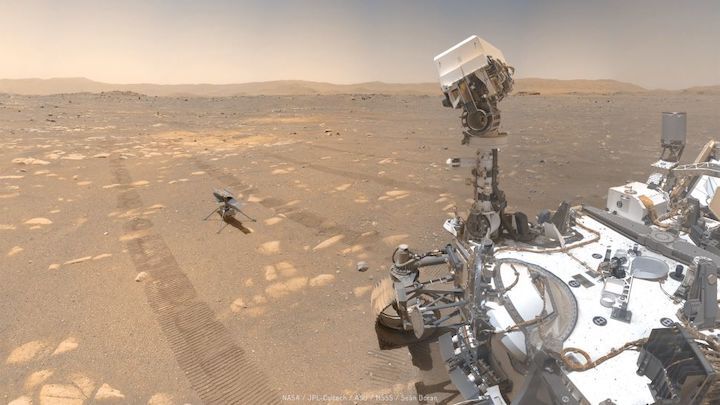
Citizen scientist Seán Doran created this mosaic of NASA's Mars rover Perseverance and Ingenuity helicopter, using 62 images captured by Perseverance on April 6, 2021.
Ingenuity remains in good health, so it should keep flying for a while yet, helping Perseverance explore the ancient river delta that once existed within Jezero. And Ingenuity's work is laying the foundation for even greater Martian aerial feats in the future.
For example, engineers at JPL are already drawing up plans for bigger, more capable successors — rotorcraft that could explore Mars on their own. (All communications to and from the solar-powered Ingenuity must go through Perseverance.)
The hope is that a future Mars helicopter could fly miles or kilometers at a time, untethered to a rover, "and carry its own science instruments," Karras said. "We think there's a lot of science opportunity in that."
Quelle: SC
----
Update: 29.04.2022
.
Ingenuity Mars helicopter snaps amazing photos of Perseverance rover's landing gear (video)
The shots could aid NASA and the European Space Agency's coming Mars sample-return campaign.
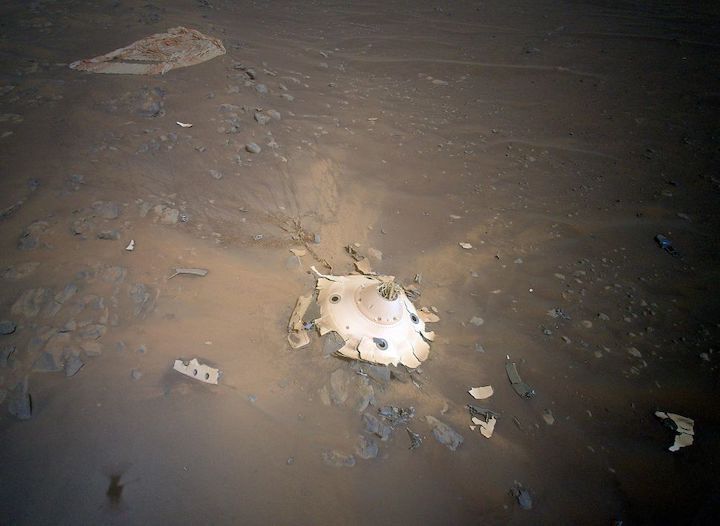
The backshell and parachute that helped NASA's Perseverance Mars rover and Ingenuity helicopter land on the Red Planet in February 2021, as photographed by Ingenuity on April 19, 2022. (Image credit: NASA/JPL-Caltech)
NASA's Ingenuity Mars helicopter continues to give us Red Planet views we've never seen before.
During its most recent flight, which occurred on April 19, the 4-pound (1.8 kilograms) Ingenuity photographed the parachute and backshell that helped it and NASA's Perseverance rover land inside the Red Planet's Jezero Crater on Feb. 18, 2021.
This was no chance sighting. The Ingenuity team was asked to try and image Perseverance's landing gear to aid the joint NASA-European Space Agency Mars sample-return project, which aims to haul the material that Perseverance collects to Earth, perhaps as early as 2033.
"Perseverance had the best-documented Mars landing in history, with cameras showing everything from parachute inflation to touchdown," Ian Clark of NASA's Jet Propulsion Laboratory (JPL) in Southern California, a former Perseverance systems engineer and now the Mars Sample Return ascent phase lead, said in a statement Wednesday (April 27).
"But Ingenuity's images offer a different vantage point," Clark added. "If they either reinforce that our systems worked as we think they worked or provide even one dataset of engineering information we can use for Mars sample return planning, it will be amazing. And if not, the pictures are still phenomenal and inspiring."
The conical backshell helped Perseverance — with Ingenuity tucked in its belly — survive the long journey from the Red Planet to Earth, as well as the brief but scorching trip through Mars' atmosphere. The mission's supersonic parachute, stretching 70.5 feet (21.5 meters) wide, was the largest ever deployed on Mars. It dramatically slowed the descent of the rover, which was ultimately lowered to Jezero's floor on cables by a rocket-powered sky crane.
The backshell and parachute did their job well, as the good health of Perseverance and Ingenuity show. And initial analyses of the new Ingenuity photos suggest that the landing gear held up very well despite the tremendous stresses they endured. (The backshell is in pieces, but that's unsurprising given that it hit the Martian surface at about 78 mph, or 126 kph, on landing day.)
For example, "the backshell's protective coating appears to have remained intact during Mars atmospheric entry. Many of the 80 high-strength suspension lines connecting the backshell to the parachute are visible and also appear intact," JPL officials wrote in the same statement.
And, though just one-third of the chute is visible in Ingenuity's images, "the canopy shows no signs of damage from the supersonic airflow during inflation," JPL officials added in the statement. "Several weeks of analysis will be needed for a more final verdict."
During the 159-second-long April 19 flight, Ingenuity took 10 photos of the backshell and parachute from a variety of perspectives. The helicopter traveled a total of 1,181 feet (360 meters) on the sortie, flying at an altitude of 26 feet (8 m), JPL officials said.

Wide view of the parachute and backshell that helped NASA's Perseverance rover and Ingenuity helicopter land safely in February 2021. Ingenuity captured this shot during a flight on April 19, 2022. (Image credit: NASA/JPL-Caltech)
"To get the shots we needed, Ingenuity did a lot of maneuvering, but we were confident because there was complicated maneuvering on flights 10, 12 and 13," Håvard Grip, chief pilot of Ingenuity at JPL, said in the same statement.
The flight was Ingenuity's 26th on the Red Planet, and it occurred on the one-year anniversary of its history-making first Martian sortie.
Ingenuity is a technology demonstration, originally tasked with a five-flight mission designed to show that aerial exploration is possible on Mars. The rotorcraft is now operating on an extended mission, pushing the boundaries of Red Planet flight and serving as a scout for the life-hunting, sample-collecting Perseverance.
Perseverance recently reached the remnants of a river delta that existed on Jezero's floor billions of years ago. The rover team is excited to study and sample the area, which may hold evidence of ancient Red Planet life. And Ingenuity, which is not quite there yet, will be a big part of this effort.
"Upon reaching the delta, Ingenuity’s first orders may be to help determine which of two dry river channels Perseverance should climb to reach the top of the delta," JPL officials wrote in the statement.
"Along with route-planning assistance, data provided by the helicopter will help the Perseverance team assess potential science targets," they added. "Ingenuity may even be called upon to image geologic features too far afield for the rover to reach or to scout landing zones and sites on the surface where sample caches could be deposited for the Mars Sample Return program."
Quelle: SC
+++
Ingenuity helicopter flies over leftover wreckage from Mars landing last year
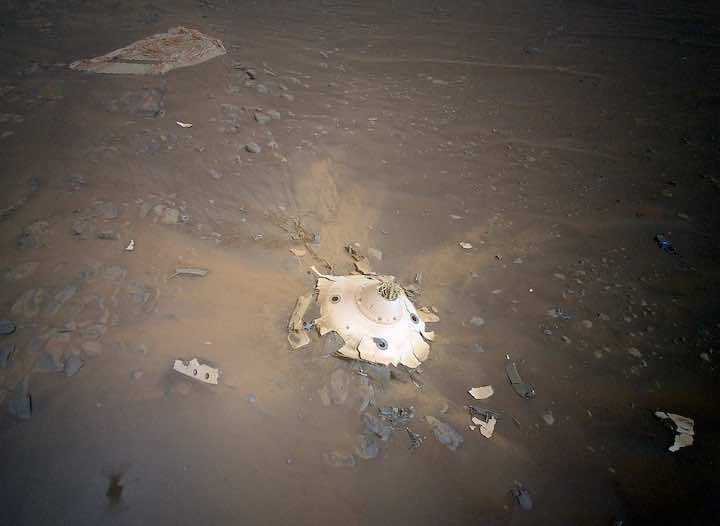
The supersonic parachute and back shell from NASA’s Perseverance rover on the surface Mars. Credit: NASA-JPL/Caltech
NASA’s flying drone on Mars has recorded aerial views of debris left behind from the landing of the Perseverance rover last year, showing remarkable details of the craft’s supersonic parachute and part of its aeroshell.
The robotic Ingenuity helicopter flew over the parachute and back shell April 19 after cameras on the Perseverance rover itself spotted the hardware from a distance. The rover will not be guided to take an up-close look at the hardware, but the Ingenuity helicopter captured 10 pictures of the chute and back shell from an altitude of about 26 feet (8 meters).
NASA engineers working on the Mars Sample Return program, which aims to bring Martian rock specimens back to Earth, requested the flyover by the Ingenuity helicopter. The 10 color images will allow engineers to examine the condition of the back shell and parachute, providing new insights into how they performed when the Perseverance rover arrived on Mars on Feb. 18, 2021.
“Perseverance had the best-documented Mars landing in history, with cameras showing everything from parachute inflation to touchdown,” said Ian Clark, an engineer at NASA’s Jet Propulsion Laboratory and former Perseverance systems engineer.
“But Ingenuity’s images offer a different vantage point,” said Clark, now in charge of the ascent portion of the Mars Sample Return mission. “If they either reinforce that our systems worked as we think they worked or provide even one dataset of engineering information we can use for Mars Sample Return planning, it will be amazing. And if not, the pictures are still phenomenal and inspiring.”
Ingenuity visited the wreckage on its 26th flight, which occurred on the one-year anniversary of the small helicopter’s first hop on the Red Planet. Ingenuity became the first aircraft to fly in the atmosphere of another planet. It was originally slated to fly five times as a technology demonstration experiment, but now NASA is using the helicopter as an aerial scout to assist the Perseverance rover with its science mission.
“NASA extended Ingenuity flight operations to perform pioneering flights such as this,” said Teddy Tzanetos, Ingenuity’s team lead at JPL. “Every time we’re airborne, Ingenuity covers new ground and offers a perspective no previous planetary mission could achieve. Mars Sample Return’s reconnaissance request is a perfect example of the utility of aerial platforms on Mars.”
Mars rovers have examined their leftover debris before. NASA’s Opportunity rover encountered its heat shield in 2005, about a year after landing on the Red Planet. But Ingenuity offered engineers a chance to inspect the landing hardware without sending the rover itself to look at it, allowing Perseverance to continue its scientific campaign.
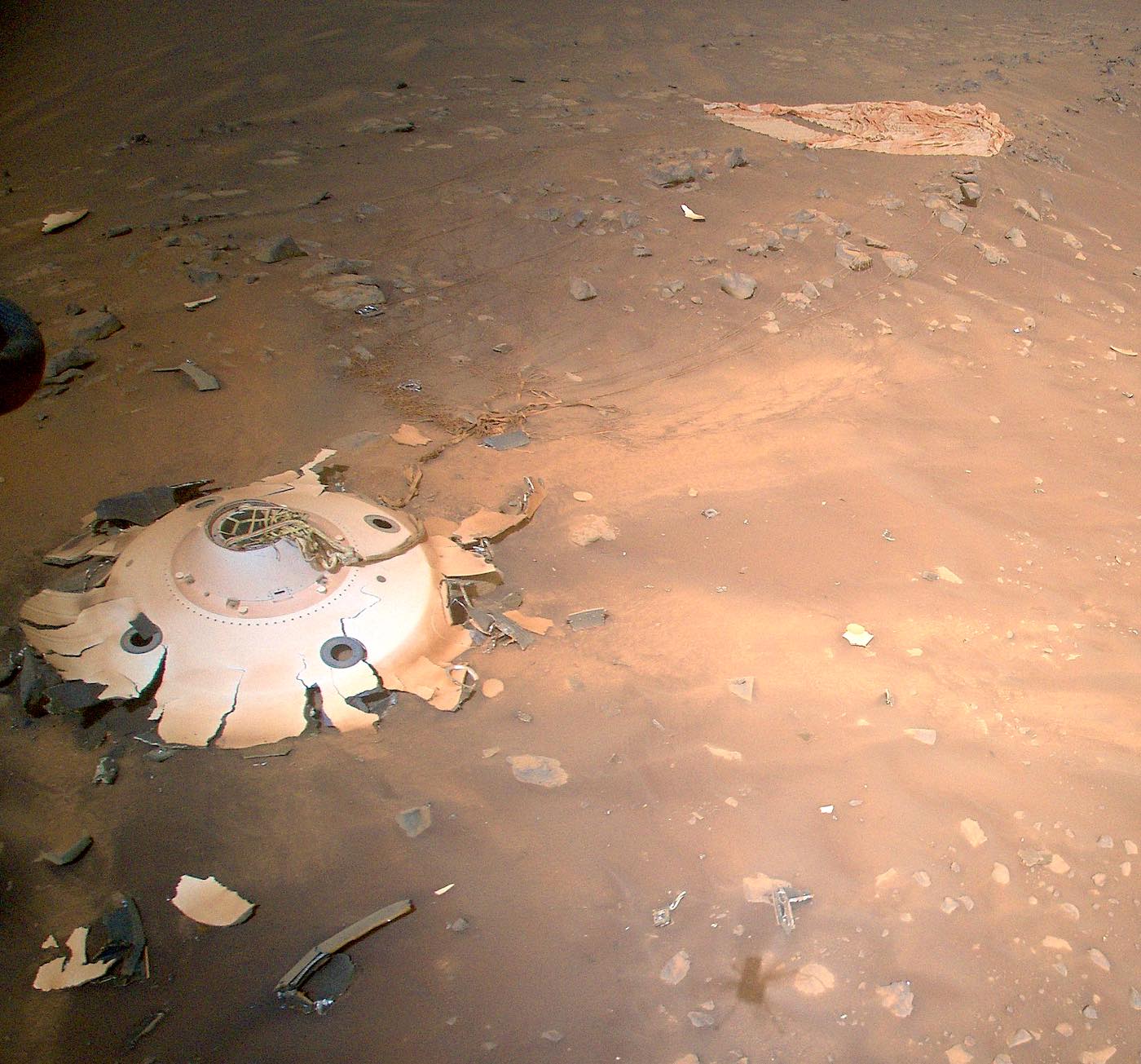
The back shell was part of the structure that housed the Perseverance rover during the journey from Earth to Mars. The aeroshell shielded the robot from aerodynamic forces and heat as the spacecraft plunged into the Martian atmosphere at a velocity of nearly 12,500 mph (20,000 kilometers per hour).
The rover jettisoned the parachute and back shell about a minute before landing in Jezero Crater, a basin once covered in liquid water fed by a river flowing down from nearby highlands. The rover then slowed for landing with the help of a rocket pack, which lowered Perseverance to the surface of Mars on cables and bridles in a technologically complex method NASA calls the “sky crane.”
The mission’s supersonic parachute measured 70.5 feet (21.5 meters) wide when fully inflated. But the rarefied atmosphere on Mars meant the rover couldn’t slow for landing using aerodynamic braking alone, so the chute was jettisoned to free up the craft to finish the landing with its rocket-powered descent stage.
The back shell measured nearly 15 (4.5 meters) in diameter, and NASA said the debris impacted the Martian surface at about 78 mph (126 kilometers per hour).
“The back shell’s protective coating appears to have remained intact during Mars atmospheric entry,” NASA said. “Many of the 80 high-strength suspension lines connecting the backshell to the parachute are visible and also appear intact.”
The parts of the parachute visible to the Ingenuity helicopter appeared to show no signs of damage from the supersonic airflow it encountered during descent last year. NASA said engineers will spend several weeks analyzing the imagery before making any concrete conclusions.
The one-ton, plutonium-powered Perseverance rover is on a mission to collect samples for return to Earth, the first leg of the multi-launch Mars Sample Return program. NASA and the European Space Agency plan to send a send a series of spacecraft to Mars later this decade to fetch the samples gathered by Perseverance, launch them off of the Red Planet and into space, then bring the specimens back to Earth for analysis in sophisticated terrestrial labs.
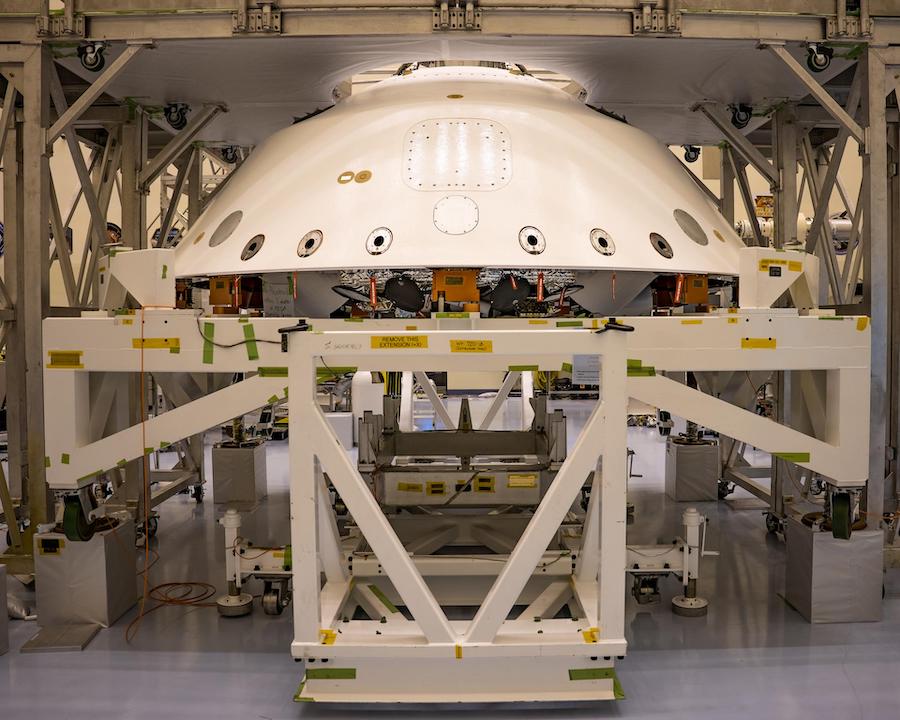
The Ingenuity flight April 19 lasted 159 seconds and occurred around midday local time on Mars. The 4-pound (1.8-kilogram) rotorcraft accomplished several maneuvers to crisscross the area around the parachute and back shell, covering 1,181 feet (360 meters) in total.
In its 26 flights so far, Ingenuity has logged more than 49 minutes aloft and traveled 3.9 miles (6.2 kilometers), according to NASA.
“To get the shots we needed, Ingenuity did a lot of maneuvering, but we were confident because there was complicated maneuvering on flights 10, 12, and 13,” said Håvard Grip, chief pilot of Ingenuity at JPL. “Our landing spot set us up nicely to image an area of interest for the Perseverance science team on Flight 27, near ‘Séítah’ ridge.”
Ingenuity and Perseverance are now operating in a more rugged region in a dried-up river delta where water once flowed into Jezero Crater. The rover completed the first phase of its mission close to where it landed on the Red Planet last year, then drove across the Martian landscape to the new area of operations, covering about 3 miles (5 kilometers) in 31 days, the quickest traverse by any Mars rover in history.
Perseverance arrived at the delta region earlier this month. The rover will collect more rock samples there, and store them for eventual return to Earth. Scientists are eager to analyze the specimens in search for clues about the environment on Mars billions of years ago, when the planet was warmer, wetter, and could have harbored life.
Ingenuity will help mission planners determine which routes the rover should take to explore the fan-shaped delta.
Quelle: SN
----
Update: 10.05.2022
.
NASA's Ingenuity in contact with Perseverance after communications dropout
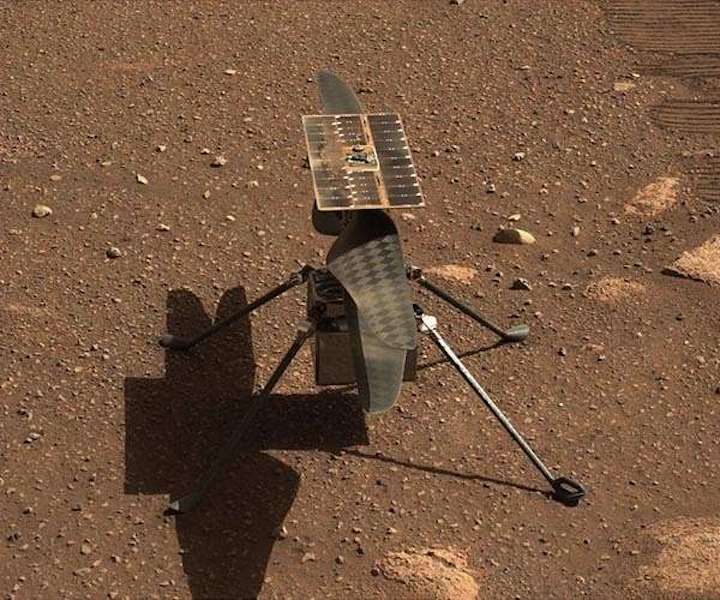
On Thursday, May 5, mission controllers at NASA's Jet Propulsion Laboratory received confirmation that the agency's Ingenuity Mars Helicopter had re-established communications with the Perseverance rover. Earlier in the week, the rotorcraft had missed a planned communications session with the rover - for the first time in over a year of operations on the Mars surface. Ingenuity relies on Perseverance as the base station that enables it to send data to and receive commands from Earth. While more data downlinks and analysis are needed, the Ingenuity and Perseverance teams believe they have determined a cause of the anomaly as well as a plan to return to normal operations.
Ingenuity became the first powered aircraft to operate on another world on April 19, 2021. Designed to perform up to five experimental test flights over a span of 30 Martian days (sols), or close to 31 Earth days, the rotorcraft has flown over 4.2 miles (6.9 kilometers) across 28 sorties and operated from the surface of the Red Planet for over a year.
Data downlinked indicates that the communications dropout on May 3, Sol 427 of the Perseverance rover's mission at Mars, was a result of the solar-powered helicopter entering a low-power state, potentially due to the seasonal increase in the amount of dust in the Martian atmosphere and lower temperatures as winter approaches. The dust diminishes the amount of sunlight hitting the solar array, reducing Ingenuity's ability to recharge its six lithium-ion batteries. When the battery pack's state of charge dropped below a lower limit, the helicopter's field-programmable gate array (FPGA) was powered down.
The FPGA manages Ingenuity's operational state, switching the other avionics elements on and off as needed to maximize power conservation. It also operates the heaters that enable the helicopter to survive frigid Martian nights, maintains precise spacecraft time, and controls when the helicopter is scheduled to wake up for communications sessions with Perseverance.
When the FPGA lost power during the Martian night, the helicopter's onboard clock - which designates the time that communications with Perseverance occur - reset. And Ingenuity's heaters, so vital to keeping electronics and other components within operational temperatures - turned off. When the Sun rose the next morning and the solar array began to charge the batteries, the helicopter's clock was no longer in sync with the clock aboard the rover. Essentially, when Ingenuity thought it was time to contact Perseverance, the rover's base station wasn't listening.
To make sure Perseverance would hear a call, Perseverance mission controllers at JPL commanded the rover to spend almost all of Sol 429 (May 5) listening for the helicopter's signal. It came at 11:45 a.m. local Mars time. The data transmitted was limited to deliberately preserve battery charge, but the helicopter's critical health and safety data were nominal. The radio link between Ingenuity and Perseverance was stable, spacecraft temperatures were within expectation, the solar array was recharging the battery at a rate expected for this season, and the battery was healthy, containing 41% of a full charge.
But one radio communications session does not mean Ingenuity is out of the woods. The increased (light-reducing) dust in the air means charging the helicopter's batteries to a level that will allow important components (like the clock and heaters) to remain energized throughout the night presents a significant challenge.
Each night for the past three sols, Ingenuity's heaters have kicked in when its battery temperature was below 5 degrees Fahrenheit (minus 15 degrees Celsius). While on, the heaters kept the temperature of vital helicopter components from dropping farther - down to the ambient environmental temperature of minus 112 degrees Fahrenheit (minus 80 degrees Celsius). But the team believes that the battery couldn't sustain the energy draw of the onboard heaters throughout the night.
"We have always known that Martian winter and dust storm season would present new challenges for Ingenuity, specifically colder sols, an increase in atmospheric dust, and more frequent dust storms," said Ingenuity Team Lead Teddy Tzanetos of NASA's Jet Propulsion Laboratory in Southern California. "Every flight and every mile of distance flown beyond our original 30-sol mission has pushed the spacecraft to its limits each and every sol on Mars."
The Ingenuity and Perseverance teams have designed a plan they hope will make a difference. Their goal is to help the helicopter's battery accumulate enough of a charge during the next few sols so that it could support all necessary spacecraft systems during the cold Martian night. Uplinked yesterday, the new commands lower the point at which the helicopter energizes its heaters from when the battery falls below 5 degrees Fahrenheit (minus 15 degrees Celsius) to minus 40 degrees Fahrenheit (minus 40 degrees Celsius).
The helicopter then shuts down quickly, rather than consuming the battery charge with the heaters. The team hopes this strategy will allow the battery to retain whatever charge it collected during the day. The Ingenuity engineers hope that after several days of the helicopter's array soaking in the limited rays, the battery will have reached a point where the spacecraft can return to normal operations.
Allowing the heaters to remain off overnight will conserve significant battery energy but will also expose components to the cold of Martian night. Developed as a technology demonstration to prove that powered, controlled flight on Mars is possible, the 4-pound (1.8-kilogram) rotorcraft carries many commercial off-the-shelf parts that weren't designed for the cold of deep space operations.
"Our top priority is to maintain communications with Ingenuity in the next few sols, but even then, we know that there will be significant challenges ahead," said Tzanetos. "I could not be prouder of our team's performance over the last year, let alone our aircraft's incredible achievements on Mars. We are hopeful that we can accumulate battery charge in order to return to nominal operations and continue our mission into the weeks ahead."
Quelle: SD
Perseverance: Nasa rover begins key drive to find life on Mars
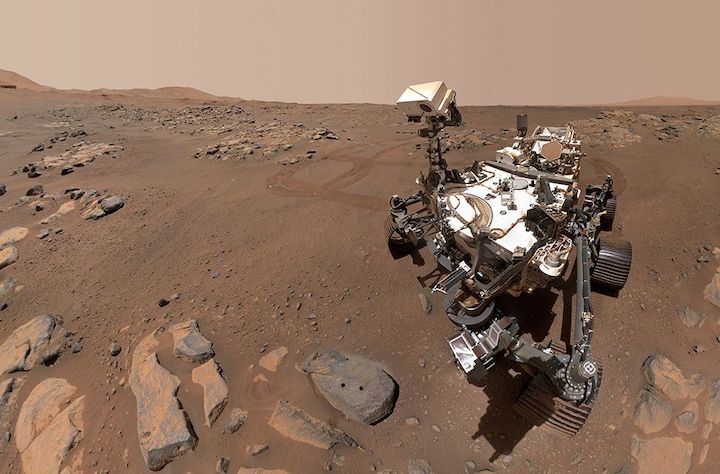
Nasa's Perseverance rover has reached a big moment in its mission on Mars.
Tuesday will see the six-wheeled robot begin the climb up an ancient delta feature in the crater where it landed.
It will roll uphill, stopping every so often to examine rocks that look to have the best chance of retaining evidence of past life on the planet.
On its way back down, Perseverance will collect some of these rocks, placing the samples at the base of the delta to be retrieved by later missions.
The goal is to bring this material back to Earth in the 2030s for detailed inspection.
"The delta in Jezero Crater is the main astrobiology target of Perseverance," said deputy project scientist, Dr Katie Stack Morgan.
"These are the rocks that we think likely have the highest potential for containing signs of ancient life and can also tell us about the climate of Mars and how this has evolved over time," she told BBC News.The rover made its spectacular landing in the middle of Mars' 45km-wide Jezero Crater on 18 February last year.
Since then it's been testing its tools and instruments, flying an experimental mini-helicopter, and gathering a general impression of its surroundings.
But the robot's chief purpose in going to the near-equatorial bowl on the Red Planet has always been to study the huge mound of sediments in the west of Jezero.
Long suspected to be a delta, based on satellite imagery, Perseverance's initial observations on the ground have now confirmed this assessment.
A delta is a structure built up from the silt and sand dumped by a river as it enters a wider body of water. The sudden deceleration that occurs in the river's flow allows anything carried in suspension to fall out.
In Jezero's case, the wider body of water was very probably a crater-wide lake that existed billions of years ago.
"Rivers that flow into a delta will bring nutrients, which are helpful for life, obviously; and then the fine-grained sediment that is brought and laid down at a high rate in a delta is good for preservation," explained mission scientist Prof Sanjeev Gupta from Imperial College London, UK.
"Also, if there is life in the hinterland, this can get brought down the river and concentrated in a delta."
In recent days, Perseverance has manoeuvred itself to an "on ramp" to the delta dubbed Hawksbill Gap. This is a gentle incline that will take the robot to an elevation of a few tens of metres above the crater floor.
The ascent is billed as a reconnaissance. Perseverance will go "walkabout", looking for the most enticing delta rock. There are some exquisitely layered, fine-grained outcrops.
"The rover has an amazing suite of instruments that can tell us about the chemistry, mineralogy and structure of the delta, by examining the sediments all the way down to the scale of a grain of salt," said mission scientist Prof Briony Horgan from Purdue University, Indiana.
"We will learn about the chemistry of this ancient lake, whether its waters were acidic or neutral, whether it was a habitable environment and what kind of life it might have supported."
To be clear, no-one knows if life ever got started on Mars, but, if it did, the three or four rocks Perseverance chooses to drill and cache on the way back down to the crater floor could be the ones to tell us.
It's unlikely the robot itself will be able to make any definitive statements - as smart as its instruments are. Even on Earth, where we know microbial life has existed for billions of years, the evidence of its earliest fossilised forms is hard to interpret, even contentious.
Establishing the facts of life on Mars will therefore have to wait for the rover's rock collection to be brought home for the type of rigorous investigation only the biggest laboratories are equipped to carry out.
"The claim that there is microscopic life on another planet in our Solar System is an enormous claim. And so the proof needs to be enormous as well," said Jennifer Trosper, Nasa's Perseverance project manager.
"I don't think that the instruments we have by themselves can provide that level of proof. They can provide a level of 'we think this might be it', and then we bring the samples back to Earth and we use the more sophisticated larger instruments here to make sure," she told BBC News.
Perseverance is expected to put down its first rock stash when it returns to the crater floor at the end of the year.
This depot will comprise not just those rocks gathered during the Hawksbill descent but four samples collected in previous months out on the crater floor.
Nasa, together with the European Space Agency, is in the advanced stages of planning the missions required to go and retrieve the depot. These ventures, which will incorporate another rover, a Mars rocket and carrier spacecraft, should be launched towards the end of this decade.
Perseverance has plenty more years of work ahead of it. After it has put down its first rock stash, it will drive back up Hawksbill Gap to the very top of the delta and beyond, to visit rocks that look like they could be the remnants of the shoreline to the ancient Jezero lake.
These deposits are made of carbonate minerals, and, again, look to have formed in a setting conducive to the recording of past life - if ever it existed.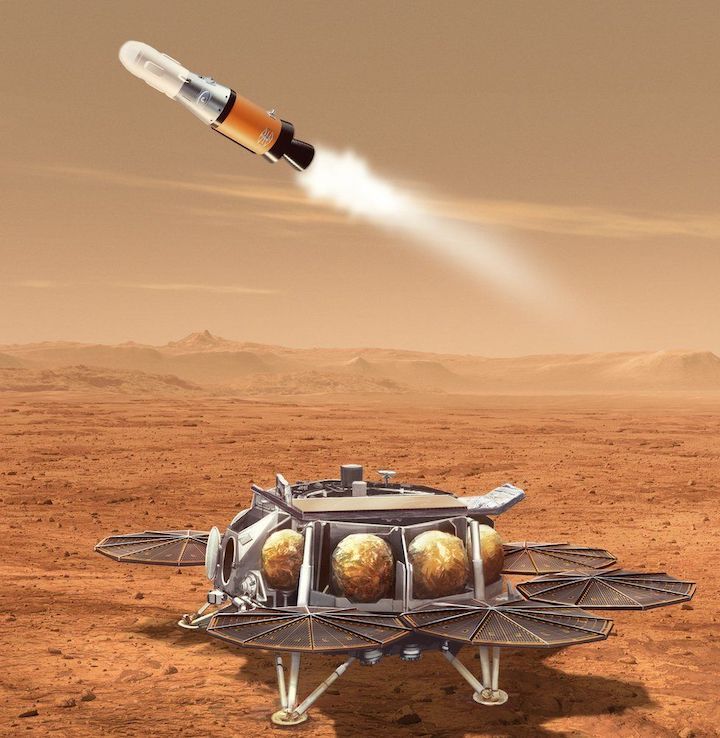
Quelle: BBC ----
Soar over Mars rover tracks with Ingenuity helicopter
Get a chopper's-eye view of Ingenuity's latest flight.
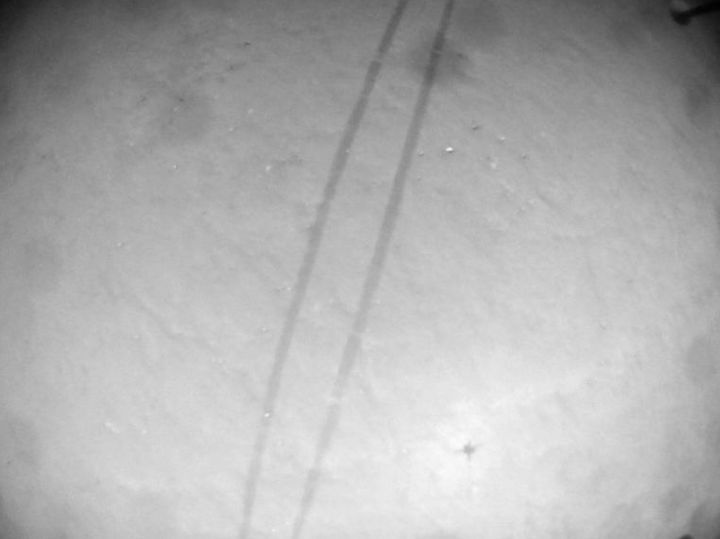 Tracks of NASA's Perseverance Mars rover, as spotted by the Ingenuity helicopter during its 28th flight on April 29, 2022. (Image credit: NASA/JPL-Caltech)
Tracks of NASA's Perseverance Mars rover, as spotted by the Ingenuity helicopter during its 28th flight on April 29, 2022. (Image credit: NASA/JPL-Caltech)
The solar-powered Ingenuity has performed incredibly well on the Red Planet, as its longevity and jam-packed flight log attest. But the little craft has run into some difficulties lately.
On May 3, Ingenuity failed to check in with Perseverance as planned — its first such missed tag-up on the Red Planet. This was no small matter, because all communications between Ingenuity and its handlers on Earth must go through Perseverance. Mission team members were able to get the two robots back in touch two days later, and they believe they know what caused the dropout.
Downlinked data indicate the anomaly "was a result of the solar-powered helicopter entering a low-power state, potentially due to the seasonal increase in the amount of dust in the Martian atmosphere and lower temperatures as winter approaches," David Agle, a media representative at NASA's Jet Propulsion Laboratory (JPL) in Southern California, which manages the missions of both Ingenuity and Perseverance, wrote in an update earlier this month(opens in new tab).
"The dust diminishes the amount of sunlight hitting the solar array, reducing Ingenuity's ability to recharge its six lithium-ion batteries," Agle added. The Ingenuity and Perseverance teams have worked out a plan that they hope will get the helicopter flying again in the near future. They've sent commands that lower the temperature at which Ingenuity's onboard heaters kick on, potentially allowing the helicopter's batteries to hold onto more charge.
"I could not be prouder of our team's performance over the last year, let alone our aircraft's incredible achievements on Mars," Ingenuity Team Lead Teddy Tzanetos of JPL said in the recent update. "We are hopeful that we can accumulate battery charge in order to return to nominal operations and continue our mission into the weeks ahead."
Ingenuity had been on quite a run before encountering problems earlier this month, flying five times in the month of April alone.
Quelle: SC
----
Update: 30.05.2022
.
NASA’s Ingenuity Mars Helicopter Captures Video of Record Flight
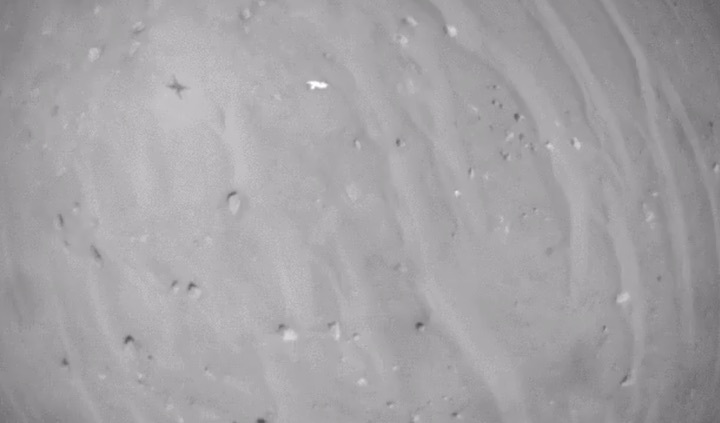
NASA’s Ingenuity Mars Helicopter made a record-breaking 25th flight on April 8, 2022. The navigation camera aboard the rotorcraft captured its longest and fastest flight to date on the Red Planet. The helicopter covered 2,310 feet (704 meters) at a max speed of 12 mph (5.5 meters per second).
Imagery has come down from Mars capturing a recent flight in which the rotorcraft flew farther and faster than ever before.
The Ingenuity Mars Helicopter’s black-and-white navigation camera has provided dramatic video of its record-breaking 25th flight, which took place on April 8. Covering a distance of 2,310 feet (704 meters) at a speed of 12 mph (5.5 meters per second), it was the Red Planet rotorcraft’s longest and fastest flight to date. (Ingenuity is currently preparing for its 29th flight.)
“For our record-breaking flight, Ingenuity’s downward-looking navigation camera provided us with a breathtaking sense of what it would feel like gliding 33 feet above the surface of Mars at 12 miles per hour,” said Ingenuity team lead Teddy Tzanetos of NASA’s Jet Propulsion Laboratory in Southern California.
The first frame of the video clip begins about one second into the flight. After reaching an altitude of 33 feet (10 meters), the helicopter heads southwest, accelerating to its maximum speed in less than three seconds. The rotorcraft first flies over a group of sand ripples then, about halfway through the video, several rock fields. Finally, relatively flat and featureless terrain appears below, providing a good landing spot. The video of the 161.3-second flight was speeded up approximately five times, reducing it to less than 35 seconds.
The navigation camera has been programmed to deactivate whenever the rotorcraft is within 3 feet (1 meter) of the surface. This helps ensure any dust kicked up during takeoff and landing won’t interfere with the navigation system as it tracks features on the ground.
Ingenuity’s flights are autonomous. “Pilots” at JPL plan them and send commands to the Perseverance Mars rover, which then relays those commands to the helicopter. During a flight, onboard sensors – the navigation camera, an inertial measurement unit, and a laser range finder – provide real-time data to Ingenuity’s navigation processor and main flight computer, which guide the helicopter in flight. This enables Ingenuity to react to the landscape while carrying out its commands.
Mission controllers recently lost communication with Ingenuity after the helicopter entered a low-power state. Now that the rotorcraft is back in contact and getting adequate energy from its solar array to charge its six lithium-ion batteries, the team is looking forward to its next flight on Mars.
More About Ingenuity
The Ingenuity Mars Helicopter was built by JPL, which also manages the project for NASA Headquarters. It is supported by NASA’s Science Mission Directorate. NASA’s Ames Research Center in California’s Silicon Valley and NASA’s Langley Research Center in Hampton, Virginia, provided significant flight performance analysis and technical assistance during Ingenuity’s development. AeroVironment Inc., Qualcomm, and SolAero also provided design assistance and major vehicle components. Lockheed Space designed and manufactured the Mars Helicopter Delivery System.
At NASA Headquarters, Dave Lavery is the program executive for the Ingenuity Mars Helicopter.
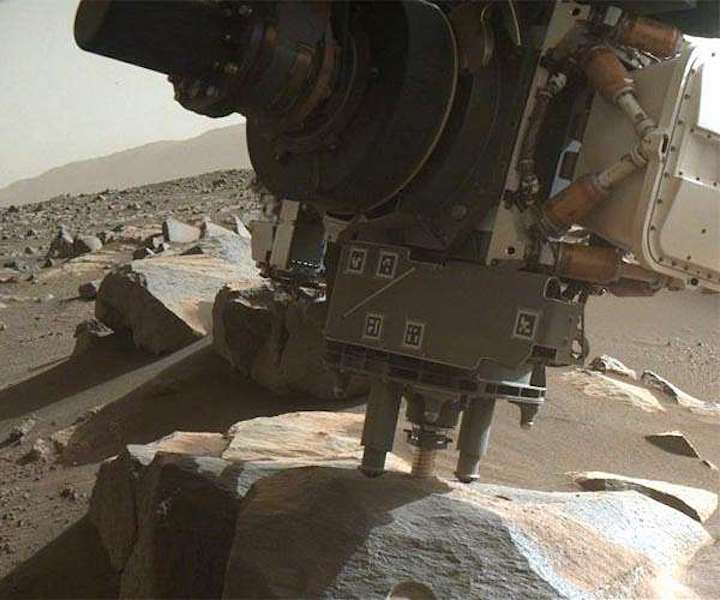
Perseverance has a number of moving parts, including the robotic arm, drill, mast, instrument covers, high gain antenna, and mobility system. An unintended collision with the rover body or Martian terrain during motion could cause irreparable damage. In addition, the SuperCam instrument shoots the LIBS laser at the surface to create a plasma and perform spectroscopy, and we also want to prevent the laser from zapping any part of the rover.
To avoid this, Perseverance checks upcoming moves and laser firing using its Rover Collision Model flight software and autonomously stops any activity before a collision could happen. To perform robotic arm collision checks Perseverance projects the next arm move into the future and checks if at any point in that move it would collide with the rover body. If the predicted move has no unexpected collisions, it allows commencing motion.
At times the arm does need to get very close to hardware or even touch other parts of the rover body, such as during docking to exchange drill bits or cache sample. The rover knows when the contacts are intentional and allows them to occur. When Perseverance autonomously selects science targets onboard using AEGIS, it uses the Rover Collision Model to filter out any targets that may result in collisions before selecting a target for SuperCam targeting.
Typically the operations team sends commands to the rover once a sol and Perseverance needs to protect itself if some of those activities don't go as planned. If the drill were to encounter even a minor fault, as occurred on Sol 374, the robotic arm could unexpectedly still be in front of the rover, touching the target. The planned LIBS firing in a continuation of the same plan the next morning was pointed to zap a rock that was now blocked by the arm. This was gracefully averted as intended by the Rover Collision Model on Sol 375.
Collision checking autonomously happens onboard, and the operations team does not typically perform any explicit commanding. Unless a move fails a collision check during ground simulation and needs to be adjusted, the operations team may not even notice it. Rover Collision Model was one of the flight software modules I designed and programmed, so I can't help but think of what it's doing in the background. As of sol 460, it has performed over 64,000 collision checks on Mars without error, reporting collisions where expected.
We've arrived at Hogwallow Flats. I'm looking forward to seeing the rover check for many more collisions and zaps as it performs some exciting science investigation.
Quelle: SD
